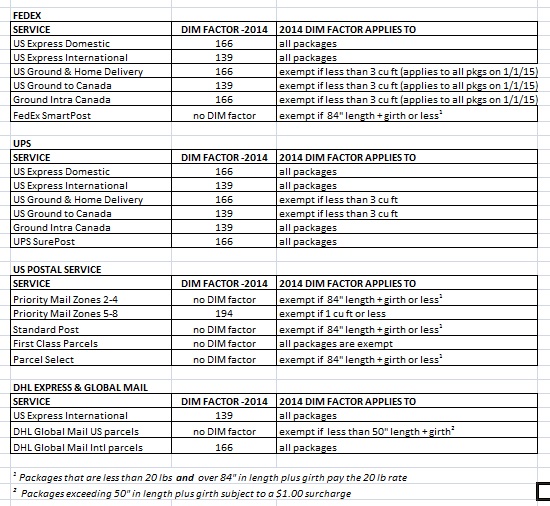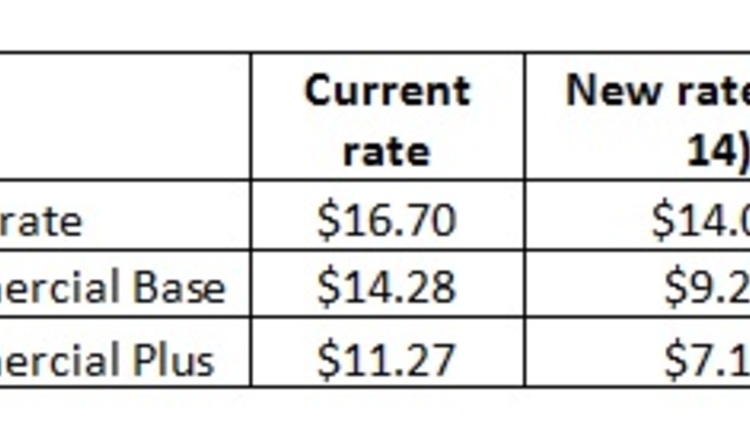Late on a Friday afternoon in early May, FedEx dropped a bombshell — effective January 1, 2015, all Ground shipments, regardless of size, will be subject to DIM (short for dimensional) charges. For many shippers, this will amount to a double-digit rate increase, and that will be on top of the yet-to-be-announced 2015 rate increases (last year's increase was 4.9%). Currently, only an estimated 15% of FedEx ground shipments — those 3 cubic feet or greater — are subject to these charges. FedEx now delivers about 4.6 million ground packages per day, so that’s 3.9 million new daily packages that will now be subject to the charges. Although we have not heard yet from the other carriers, it’s a pretty safe bet that most will follow suit. So regardless of the carriers that you currently use, there is a very good chance that at least some of your shipments will be affected by these new charges.
First, let’s look at the events that precipitated this change, and then we’ll explore some options on how to reduce – or even eliminate – the impact of these charges.
Why the change now? For years, the carriers have experienced explosive growth in B2C shipments, and those shipments are starting to take a toll on these carriers’ pickup and delivery networks. UPS and FedEx now capture the dimensions of each shipment while in transit, and they have taken note that many of these new shipments are in relatively large, but lightweight boxes. For both carriers, virtually all of their transportation modes — including trailers spotted at shippers' locations, cargo planes, tractor trailer rigs and rail vans – will often physically fill up with packages long before they hit their maximum operating weight. We are even hearing reports that some carriers’ delivery vehicles are starting to “cube out” on busy days. Normally, a delivery van is loaded with the packages for the entire route in the morning, and returns to the station at the end of the day. However, if the delivery vehicle “cubes out,” the driver will be forced to return to the station in the middle of the route to reload, and costs will skyrocket. The only other alternative is for the carriers to replace their delivery fleets with larger vehicles — an extremely costly proposition. FedEx is hoping to change shippers’ behavior with these new rules, before that becomes a common occurrence.
Here are the current dimensional factors for FedEx, UPS and the Postal Service — the higher the DIM number, the higher the potential for additional charges:
DIM factors are really a measurement of the density of each package, expressed in pounds per cubic foot, or PCF. Here are the PCFs for common DIM factors:
194 DIM — minimum 8.9 lbs per cu ft. Until January of 2011, the U.S. domestic factor for UPS and FedEx. Note that the Postal Service still uses 194, and so does at least one regional carrier — OnTrac Ground.
166 DIM — minimum 10.4 lbs per cu ft. This was the US factor for international shipments until January of 2011. 166 is the new domestic factor for UPS and FedEx, adopted in 2011. Confused yet?
139 DIM — minimum 12.4 lbs per cu ft. This is the new international factor for UPS and FedEx international shipments.
115 DIM — minimum 15 lbs per cu ft. Not currently used in the United States, but this factor is used by some carriers in Canada, Europe and Asia.
First, let’s look at the events that precipitated this change, and then we’ll explore some options on how to reduce – or even eliminate – the impact of these charges.
Why the change now? For years, the carriers have experienced explosive growth in B2C shipments, and those shipments are starting to take a toll on these carriers’ pickup and delivery networks. UPS and FedEx now capture the dimensions of each shipment while in transit, and they have taken note that many of these new shipments are in relatively large, but lightweight boxes. For both carriers, virtually all of their transportation modes — including trailers spotted at shippers' locations, cargo planes, tractor trailer rigs and rail vans – will often physically fill up with packages long before they hit their maximum operating weight. We are even hearing reports that some carriers’ delivery vehicles are starting to “cube out” on busy days. Normally, a delivery van is loaded with the packages for the entire route in the morning, and returns to the station at the end of the day. However, if the delivery vehicle “cubes out,” the driver will be forced to return to the station in the middle of the route to reload, and costs will skyrocket. The only other alternative is for the carriers to replace their delivery fleets with larger vehicles — an extremely costly proposition. FedEx is hoping to change shippers’ behavior with these new rules, before that becomes a common occurrence.
Here are the current dimensional factors for FedEx, UPS and the Postal Service — the higher the DIM number, the higher the potential for additional charges:

To calculate the DIM, multiply the length times the width times the height, and divide the result by the DIM factor. Round up that number, and if it’s higher than the actual weight of the package, you will pay the dimensional weight. Here’s an example of a 12 lb zone 8 ground residential shipment in a 14” X 14” X 14” box, with a DIM factor of 166:
14 X 14X 14=2,744 cubic ins/166=16.5, rounded up to 17 lbs. Under the 2014 rule, this package would be billed at the 12 lb rate of $19.67 with fuel. If the new rule were in effect today, this package would be billed at the 17 lb rate — $24.26 — a 23% increase.
14 X 14X 14=2,744 cubic ins/166=16.5, rounded up to 17 lbs. Under the 2014 rule, this package would be billed at the 12 lb rate of $19.67 with fuel. If the new rule were in effect today, this package would be billed at the 17 lb rate — $24.26 — a 23% increase.
DIM factors are really a measurement of the density of each package, expressed in pounds per cubic foot, or PCF. Here are the PCFs for common DIM factors:
194 DIM — minimum 8.9 lbs per cu ft. Until January of 2011, the U.S. domestic factor for UPS and FedEx. Note that the Postal Service still uses 194, and so does at least one regional carrier — OnTrac Ground.
166 DIM — minimum 10.4 lbs per cu ft. This was the US factor for international shipments until January of 2011. 166 is the new domestic factor for UPS and FedEx, adopted in 2011. Confused yet?
139 DIM — minimum 12.4 lbs per cu ft. This is the new international factor for UPS and FedEx international shipments.
115 DIM — minimum 15 lbs per cu ft. Not currently used in the United States, but this factor is used by some carriers in Canada, Europe and Asia.
Steps to take now
Survey Your Current Packages
Some shippers already employ in-line cubing equipment, which electronically measures the dimensions of each package. If you don’t have cubing equipment but have a large number of packages to survey, you can now rent a portable cubing station. Some shippers employ “cartonization logic” software, which optimizes the carton size for each shipment prior to pick and pack. If you don’t have either, you’ll probably need to manually survey a good cross section of your shipments. You should record the external dimensions in 1/8” increments (don’t rely on the carton manufacturer’s dimensions, which may be the inside dimensions of the box). Secondly, record the actual scale weight of the box in fractions of a pound. Finally, multiply the length, width and height, then divide the result by the scale weight, to get the lbs per cubic ft — abbreviated PCF. If the PCF is 10.4 or higher, you’re probably home free, and you shouldn’t be impacted by the changes (at least for domestic shipments). If your PCF is lower than 10.4 on some of your packages, you’ll need to look at your options.
Survey Your Current Packages
Some shippers already employ in-line cubing equipment, which electronically measures the dimensions of each package. If you don’t have cubing equipment but have a large number of packages to survey, you can now rent a portable cubing station. Some shippers employ “cartonization logic” software, which optimizes the carton size for each shipment prior to pick and pack. If you don’t have either, you’ll probably need to manually survey a good cross section of your shipments. You should record the external dimensions in 1/8” increments (don’t rely on the carton manufacturer’s dimensions, which may be the inside dimensions of the box). Secondly, record the actual scale weight of the box in fractions of a pound. Finally, multiply the length, width and height, then divide the result by the scale weight, to get the lbs per cubic ft — abbreviated PCF. If the PCF is 10.4 or higher, you’re probably home free, and you shouldn’t be impacted by the changes (at least for domestic shipments). If your PCF is lower than 10.4 on some of your packages, you’ll need to look at your options.
Smaller Boxes May be the Answer
You will want to focus on the worst offenders first — those packages with the lowest PCF. The obvious solution is to see if smaller boxes will work. Some shippers use a limited range of box sizes, and these shippers may want to consider increasing the number of stock box sizes in inventory.
You will want to focus on the worst offenders first — those packages with the lowest PCF. The obvious solution is to see if smaller boxes will work. Some shippers use a limited range of box sizes, and these shippers may want to consider increasing the number of stock box sizes in inventory.
Use Less (or More Effective) Dunnage
Dunnage is the term for the material used to cushion the item in the carton. If you use less dunnage, you may be able to use a smaller carton. Styrofoam peanuts, although lightweight, have fallen out of favor with many shippers. Crumpled Kraft paper works well (and is easily recyclable), but can add several ounces to the shipment — and that could push the scale weight into the next higher pound. Amazon and a number of other high-volume shippers have switched almost entirely to air pillows, which offer great cushioning ability. They also weigh next to nothing, so you are not likely to push your shipments into the next weight break.
Dunnage is the term for the material used to cushion the item in the carton. If you use less dunnage, you may be able to use a smaller carton. Styrofoam peanuts, although lightweight, have fallen out of favor with many shippers. Crumpled Kraft paper works well (and is easily recyclable), but can add several ounces to the shipment — and that could push the scale weight into the next higher pound. Amazon and a number of other high-volume shippers have switched almost entirely to air pillows, which offer great cushioning ability. They also weigh next to nothing, so you are not likely to push your shipments into the next weight break.
Work with a Packaging Designer
FedEx has just opened a new “Tech Connect” state-of-the-art packaging lab in Memphis — good timing, considering the new rules. UPS offers a comprehensive package lab as well, and both of these facilities can help you redesign your packaging and meet the new dimensional rules, while still protecting your shipments from damage while in transit. In addition, most carton manufacturers offer these services, and there are a number of qualified independent designers as well. A word of caution: start the conversation now, because these labs are likely to be very busy in the coming months, due to the dimensional changes.
FedEx has just opened a new “Tech Connect” state-of-the-art packaging lab in Memphis — good timing, considering the new rules. UPS offers a comprehensive package lab as well, and both of these facilities can help you redesign your packaging and meet the new dimensional rules, while still protecting your shipments from damage while in transit. In addition, most carton manufacturers offer these services, and there are a number of qualified independent designers as well. A word of caution: start the conversation now, because these labs are likely to be very busy in the coming months, due to the dimensional changes.
Consider Your Carrier Options
As you can see from the above chart, the Postal Service has more lenient dimensional rules than UPS and FedEx, at least for now. For instance, Priority Mail for zones 2-4 (up to 600 miles) has no DIM factor because these packages stay on the ground, while zones 5-8, which travel by air, have a more lenient 194 DIM — and the DIM only applies if the package is over 1 cubic foot.
As you can see from the above chart, the Postal Service has more lenient dimensional rules than UPS and FedEx, at least for now. For instance, Priority Mail for zones 2-4 (up to 600 miles) has no DIM factor because these packages stay on the ground, while zones 5-8, which travel by air, have a more lenient 194 DIM — and the DIM only applies if the package is over 1 cubic foot.
And don’t rule out so-called regional carriers who may have more tolerant DIMs. Since regional carriers line haul distances are lower, their line haul cost may represent a lower percentage of their total costs, and that may be reflected in a more favorable DIM. For instance, OnTrac’s 2014 Ground DIM is 194, compared to 166 for UPS and FedEx.
Endicia Weighs In on Dimensional Changes
We spoke to Amine Khechfe, co-founder and general manager of Endicia, a seller of electronic postage services, who believes the price hike will prove to be a boon for the Postal Service. “This is definitely an advertisement for them,” he said. Khechfe notes that a migration of business to the Postal Service from FedEx and UPS was already underway before the FedEx announcement. Quoting from a recent report by the Colography Group, Khechfe said that “the Postal Service has seen 10-15% growth in small lightweight, 5 pounds and under parcel volume since 2011 where the Post Office is making the final delivery, whereas FedEx and UPS have both seen declines, giving USPS a significant share of this market.” Khechfe also believes that the dimensional change will likely cause many shippers to reevaluate their carrier portfolios. “I would definitely say that this dimensional announcement is going to put the Postal Service in the driver’s seat,” he said. “Based on Endicia’s analysis, a switch to the Postal Service will likely make sense for 12-inch-cube packages of up to three pounds, and even four pounds for larger shippers.”
We spoke to Amine Khechfe, co-founder and general manager of Endicia, a seller of electronic postage services, who believes the price hike will prove to be a boon for the Postal Service. “This is definitely an advertisement for them,” he said. Khechfe notes that a migration of business to the Postal Service from FedEx and UPS was already underway before the FedEx announcement. Quoting from a recent report by the Colography Group, Khechfe said that “the Postal Service has seen 10-15% growth in small lightweight, 5 pounds and under parcel volume since 2011 where the Post Office is making the final delivery, whereas FedEx and UPS have both seen declines, giving USPS a significant share of this market.” Khechfe also believes that the dimensional change will likely cause many shippers to reevaluate their carrier portfolios. “I would definitely say that this dimensional announcement is going to put the Postal Service in the driver’s seat,” he said. “Based on Endicia’s analysis, a switch to the Postal Service will likely make sense for 12-inch-cube packages of up to three pounds, and even four pounds for larger shippers.”
Avoid Invoice Shock by Acting Now
Whatever your course of action, you will want to start the planning process now. The carriers realize that some customer changes, such as redesigning packaging, can take months to implement, and that’s probably why FedEx gave its customers nearly eight months’ lead time. You won’t want to be among the shippers who wait for their first invoice in 2015 to determine the real impacts on their shipments!
Whatever your course of action, you will want to start the planning process now. The carriers realize that some customer changes, such as redesigning packaging, can take months to implement, and that’s probably why FedEx gave its customers nearly eight months’ lead time. You won’t want to be among the shippers who wait for their first invoice in 2015 to determine the real impacts on their shipments!
Doug Caldwell is the VP of International for AFMS Global Logistics Management Service in Portland Oregon. AFMS is a leading global logistics consultancy, and can assist your organization in both understanding the impact of these changes, and in moderating their impacts. Doug can be reached at 1-800-246-3521, or at doug.caldwell@afms.com.







